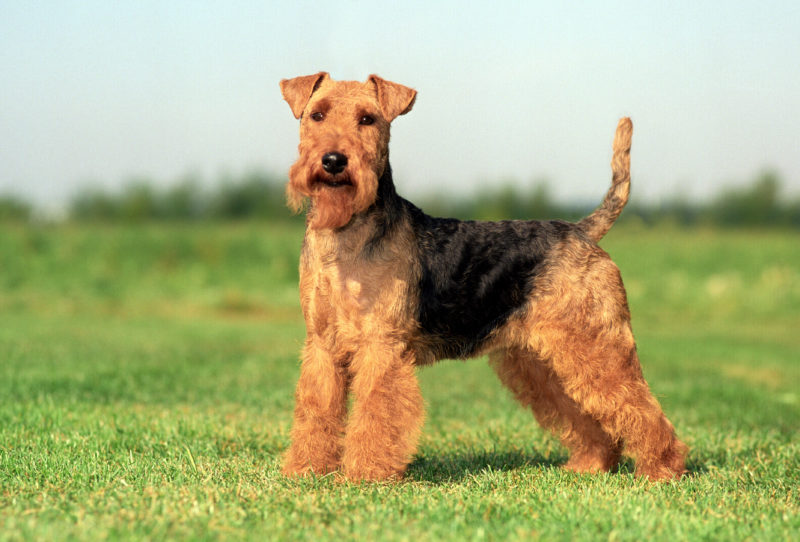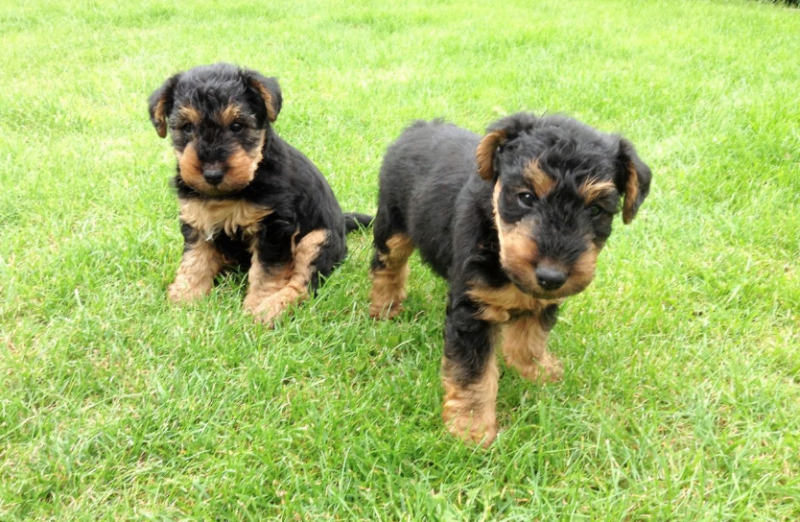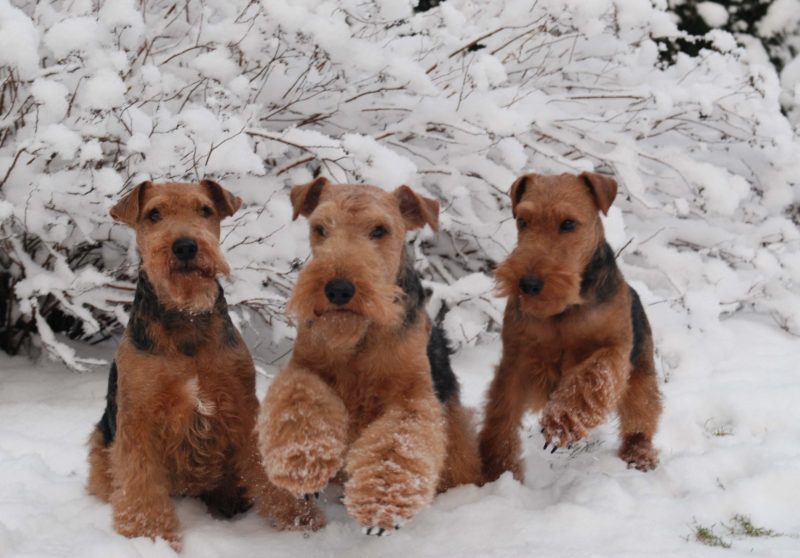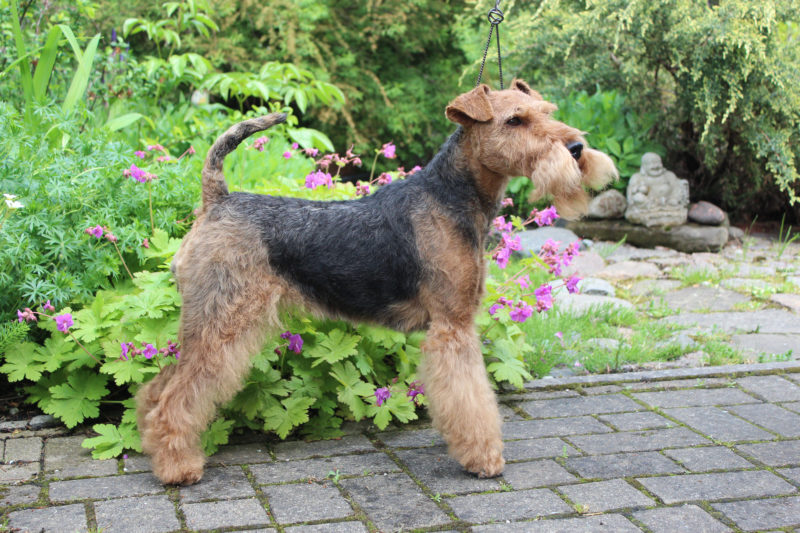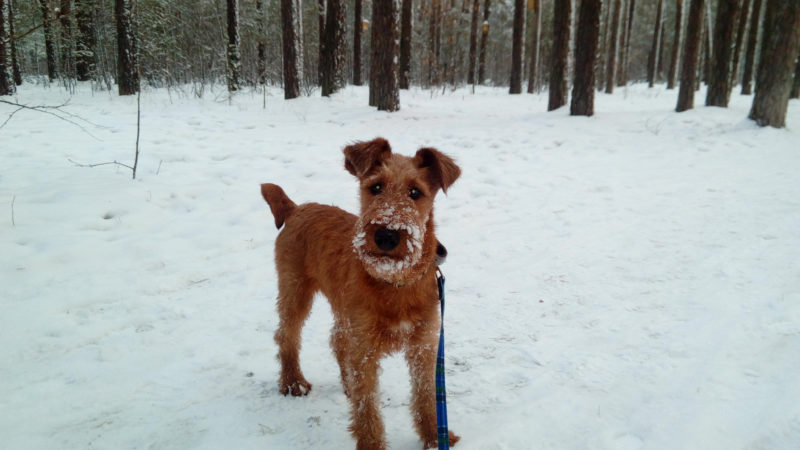A striking representative of the so-called burrow dogs is a miniature and energetic welsh terrier. This four-legged pet is active and fearless, like almost all varieties of terriers. What are the features of caring for a dog born in Wales?
Material Content:
History of breed origin
There are many varieties of terriers in the world. Some of them, such as, for example, the Old English Terrier, have long disappeared, leaving behind their descendants. One of them are representatives of a breed of hunting dogs called welsh terrier.
The first owners of these charming doggies were farmers from Wales, who with the help of these animals rid their possessions of rodents. The first mention of representatives of this breed dates back to the 16th century. Engravings depicting dogs that look like modern Welsh have survived to this day.
The breed was officially recognized in 1886, later the breed standard was approved. To date, terriers from Wales are popular in their homeland, in England, as well as in the USA and Germany.
Official breeding of these animals in Russia began in the 70s of the 20th century.
Description and character of the welsh terrier
Before acquiring a pet, a potential owner should familiarize themselves with the detailed characteristics of the Welsh Terrier breed and not confuse these dogs, for example, with an Airedale. At first glance, such dogs are very similar, but the welsh is much smaller and its coat is longer.
Tall at the withers, the Welsh Terrier reaches 36 - 38 cm with a weight of not more than 10 kg. These babies have a long neck and well-developed muscles. Due to their compact size and harmonious proportions, these little terriers are very agile and dexterous creatures. Strong legs help them easily catch prey, and strong jaws can easily cope with the pursued beast.
The current welsh terriers are small dogs with a bright black-red color and rather stiff hair, which fits tightly to the body and resembles a wire. It is thanks to such a cover that these dogs can drive game even by swimming. On the muzzle, the hair forms a kind of beard and mustache, and on the legs - panties.
Strong jaws and an elongated muzzle give the welsh terrier a masculine look. Hanging ears are triangular in shape and are high. The almond-shaped dark eyes are small. The tail is high set and can be stopped at 1/3.
As for the color of the Welsh Terrier, it can combine two or three colors. The most popular color is a mixture of red and black (black). A combination of red, gray and black is also allowed.
The Welsh Terrier cannot be called a true home or salon doggie. In view of their destiny as a hunter, these creatures are extremely active and very energetic, and sometimes somewhat stubborn.
However, Welsh is an excellent companion for all family members. The desire to please people, to serve them and to be loved by them is laid down at his genetic level. For many centuries, these animals have not lived in a booth, but at home, next to humans. Small terriers literally need the approval and praise of the owner. Having not received it, the doggie may feel unnecessary and depressed, which will not affect its psychological state and further training in the best way.
Welsh terriers are very initiative animals. This is especially noticeable during the hunting process - these doggies are able to act without an additional command and prompting from the owner. All this makes him an excellent hunter.
Puppy selection criteria
When planning to buy a welsh terrier puppy, a potential owner should answer himself several questions:
- Is he ready to spend time training a pet and walking with it?
- How great is his desire to keep the Welsh Terrier in his yard or home?
- And finally, for what purpose is the dog purchased?
Welsh can be acquired as a potential winner of exhibitions or dog competitions, a hunter, a tribal sample, or just a pet. Accordingly, the price of the animal will fluctuate depending on its further purpose.
If the decision to buy is unshakable, you should consider several recommendations before choosing a welsh terrier puppy:
- Kids should be fun and active.
- Doggie should be quite well-fed, but his stomach should not be swollen (the opposite may indicate the presence of helminths).
- Healthy individuals have silky hair without bald patches.
- The ears, like the body of the dog, should be clean, without traces of parasites, irritation or dermatitis.
Before buying, you should definitely get acquainted with the parents of the brood, because the main thing in the dog, including the Welsh Terrier, is adequacy. Breeders cherishing their reputation will not allow breeding of animals with various psychological or genetic abnormalities. Welsh babies must certainly be provided with a birth certificate, as well as a veterinary passport, in which the vaccination dates are recorded.
It is interesting! Newborn Welsh Terriers are distinguished by a black tan coat. A typical black suit appears in them only by the age of two.
Features of keeping a dog
Although the owner may have some difficulties with raising a welsh terrier, this dog is rather unpretentious in leaving.
Due to the small size, these dogs will be equally comfortable both in the apartment and in the private house. However, for a minute you should not forget about the activity, and sometimes hyperactivity of the pet. He just needs frequent walks in the fresh air and physical activity. In a country house, this problem is solved more simply - the dog will have a great time on the plot. At the same time, the owner should take into account the dog’s natural curiosity and certainly make the fence higher so that the ubiquitous welsh does not go looking for adventure.
Note. The Welsh Terrier can be kept perfectly in the enclosure, however it is strongly discouraged to put this dog on a chain.
Walking in the city, you should definitely put Welsh on a leash, because when he sees another animal, for example a stray cat, he will immediately try to overtake her.
Welsh Terrier Hair Care
Welsh's hard coat is perfectly combed and washed. And although the hairs practically do not shed, they still require some care. A doggie should be washed once every 2 months, and combed out - once a week. Wool does not fall out on its own, and therefore, the procedure for trimming the terrier should be periodically carried out, i.e., plucking of dead hairs. If this rule is neglected, the welsh terrier dog will eventually become like a tumbleweed and will begin to “litter” with hair.
Trimming should be carried out 2-3 times a year, it is best to contact professionals for this purpose.
The condition of the ears, eyes, and claws of the animal should also be systematically checked. The latter, by the way, are not always erased during the active physical activity of the dog, and therefore they should be trimmed periodically.
Pet Feeding Rules
The owner of the welsh terrier will not have to unnecessarily rack their brains over the nutritional characteristics of the pet, since he is unpretentious in food. Ready-made feeds as well as natural homemade food are equally suitable for him.
So, meat, low-fat dairy products, cereals (buckwheat, rice), vegetables, fruits and eggs should certainly be included in the diet of a welsh terrier. Do not treat your pet with flour products, pork, excessively salty or sweet dishes, as well as potatoes.
Due to the high activity and physical activity, the nutrition of the little terrier should certainly include minerals and vitamins. With ready-made feed, everything is somewhat simpler - you can buy products that already include these elements in the composition. If the dog prefers natural food, supplements can be purchased at a veterinary pharmacy.
Characteristic diseases
The average lifespan of a welsh terrier is 12 to 14 years. In general, these animals are considered quite healthy, and only some of them are prone to skin and eye diseases.
However, there are exceptions to any rule, and small terriers may suffer from the following diseases:
- atopy;
- epilepsy;
- hypothyroidism;
- dislocation of the lens of the eye;
- glaucoma;
- cataract.
In general, eye disease is much more common in these dogs than other pathologies.
To prevent such ailments, the following measures should be taken:
- Systematically inspect the organs of vision of the pet.
- Remove dirt and dust from the eyes with a cotton pad or cotton swab.
- After tracking any deviations (redness, suppuration, eye irritation), you should contact a veterinarian.
You should also worry about the timely vaccination of animals, in order to protect it from possible health problems.
Parenting and training
The Welsh Terriers are distinguished by a strong instinct of the hunter, and therefore, from early childhood, this dog should be accustomed to communicating with other animals.
To settle a new pet in a house where an adult welsh lives is fraught with consequences - a selfish loving terrier will surely try to defend its territory.
These dogs are distinguished by impressive intelligence, and therefore even a young dog can easily learn new skills and knowledge.Welsh will certainly enjoy the game form of training, and he will be happy to take part in such classes. However, these terriers can be quite stubborn. In such cases, the owner should be patient and persistently demand the execution of commands. A savvy welshman, as a rule, has a rather strict look and a raised tone of voice to understand: his behavior is by no means pleasing to the owner.
Welsh terriers will obey exclusively the leader, which means that the owner should certainly become an authority and leader for his pet. These dogs are very fond of encouragement and motivation, and therefore it is imperative to reinforce completed teams with praise and refreshments. Positive reinforcement will help the dog to master the required skills faster. But you should not constantly scold and punish Welsh - such an approach will surely discourage his craving for classes.
Due to its ingenuity, a properly educated Welsh Terrier can become a real helper: bring slippers, newspapers, put scattered toys in a basket, etc. It is from these dogs that real circus artists appear, since they are able to perform different tricks. By the way, in view of his sociability, the terrier will be happy to brag of his skills to the public.
It is best to train welsh indoors, as their curiosity and hunting habits can impede classes. The terrier can be distracted by various movements and sounds, and even when he sees a cat running past, it considers it his duty to catch up with it, neglecting the paramount tasks.
Pros and cons of the breed
Choosing a dog of the breed Welsh Terrier, the potential owner should consider all possible disadvantages of keeping this pet.
These include:
- strong dependence on the host;
- the possibility of nervous breakdowns in the process of character formation;
- tendency to tricks, mischief;
- increased irritability;
- stubbornness.
However, the breed has a welsh terrier and undeniable advantages, for example:
- activity;
- sociability;
- equilibrium;
- learning ability;
- attachment to the owner;
- endurance.
The moving and curious welsh terriers are great companions for active people. These savvy creatures from an early age are able to learn how to fulfill the requirements and commands of the owner. The attachment of these dogs to humans is very strong, the owner should remember this when acquiring the Welsh Terrier.


